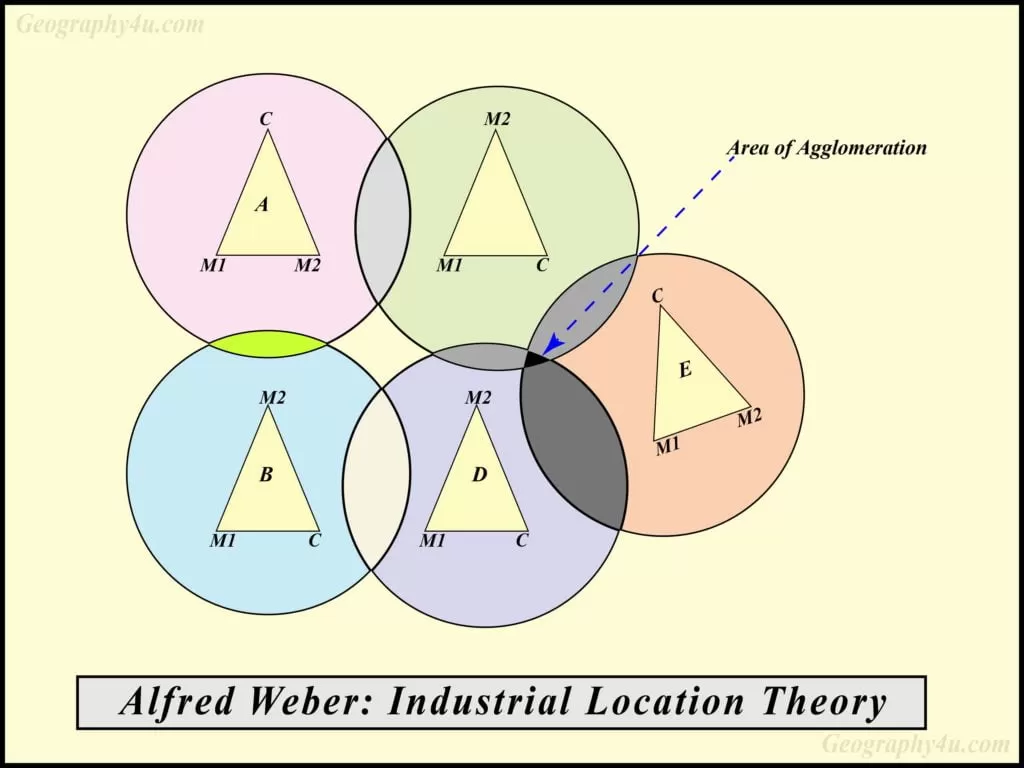Industries play a vital role in the overall economy of a nation. Many scholars have tried to give different theories on the location of the industry but, weber’s theory on industrial location is very special. So, in this article, I have discuss Weber’s theory of industrial location, factors affecting the location of an industry, the role of labour cost, transportation cost and agglomeration cost for the optimum location of an industry. This topic is very important for the geography optional of UPSC and bpsc exams.
Table of Contents
Factors affecting the location of an industry
The location of an Industry depends upon many factors. However, the following are the common factors for deciding the location of industries.
- Availability of land.
- Availability of freshwater.
- Skilled, Semi-skilled and Unskilled labour.
- Availability of raw materials.
- Government Policies.
- Market facility.
- Electricity.
- Transportation facilities etc.
However, all the aforesaid factors are not available simultaneously at a place and impact equally. For this reason, many Geographers and Economists tried to find the impact of these factors for the optimum location of an industry.
Alfred Weber’s theory of industrial location
Alfred Weber, a German Economist gave the principle of Least transportation cost for industrial location. He tried to find the least cost location of the manufacturing industry by taking into account three important factors namely, Transportation cost, Labour cost and Agglomeration cost. To reduce the complexities of real-world, he took certain assumptions.
Assumptions of Weber’s industrial location theory
- The Geographical area of industry is physically, technologically, culturally and politically uniform.
- Both the sources of raw materials and consumption centres are known.
- The transportation cost of goods is dependent on weight and distance.
- The workforce or labour are geographically fixed.
- Due to high competition, there is perfect competitive pricing among the industries.
Impact of transportation cost on the location of an industry
According to weber’s industrial location theory, if the raw materials are weight-losing or impure then the industries should be shifted towards the region of raw material. For instance, Sugar industry, Steel industry, Jute industry etc. On the contrary, if the raw material is weight gaining or pure then the location of an industry should be between the region of raw materials and the market. Apart from these, if the raw material is universally available then the industry should be shifted near the market.
Weber used the location triangle models for the manufacturing industries which use more than one raw material. According to Weber’s triangle model, the manufacturing industries are divided into two groups namely, weight-gaining industry and weight-losing industry. Therefore, the Iron and Steel industry, Cement industry etc. are come under the weight-losing industry (refer figure no.-1).


Impact of labour cost on location of an industry
According to Weber’s least labour cost theory, if the labour cost is very cheap at a specific region then the industry would be shifted from the least transportation cost to least labour cost provided the saving in labour cost would be greater than any additional transport cost. The labour cost is the major factor for the development of the cotton textile industry at the Alabama City of U.S.A and readymade garment industry in many cities of India.
Read more: Basic information about India 2020 updated
Read a complete article on basic information about India at above link

In figure no.-2, P represents the least transportation cost and the circles at the periphery of P represents the Isodopanes (the lines of equal transportation cost per unit of production). According to fig-2, the L1 and L2 are two locations which would save 15 paise per unit of production. C represents the consumption point for manufacturing goods. Any location within the 15 P Isodopane would save more on labour cost than transportation cost as it is near the consumption point. Therefore, L1 is a more profitable location than P.
Impact of Agglomeration on the location of an industry
According to Weber’s agglomeration theory of industrial location, sometimes infrastructural factors also influence the location of an industry more than the transportation cost and labour cost as many light industries and footloose industries are not able to invest in structural facilities. As per this theory, the industry should be shifted towards the agglomeration if the agglomeration factor is more powerful than the combined factors of labour cost and transportation cost. Agglomeration helps in mutual sharing of services and specialization among the industries. For instance, the development of software industries, electronic industries and readymade industries in the metropolitan regions (Bangalore-Chennai-Coimbatore industrial region) of India.

Criticism of Weber’s theory of industrial location
- Weber didn’t consider the role of demand for goods for the location of Industries. However, he overemphasized the role of supply.
- There is no region which is physically, politically, culturally and technologically uniform but, he has taken this assumption to reduce the real-world complexities.
- Due to better opportunities for employment, labours often migrate but, weber has taken labour as static.
- Weber also neglected the political factors of a location but, it has been experienced that the migration of labours also caused due to political and governmental factors.
- He overemphasized the role of transportation cost in the establishment of an Industry.
- It is not possible to find the perfect competitive pricing of goods as man seldom behaves rationally but, weber has also taken this assumption.
Do you know: What is migration? What are the factors of Migration and its consequences?
Read a complete article on Migration and its consequences at above link.
Conclusion: Despite all drawbacks, the iron and steel industry at Jamshedpur (Tata steel) in India and Essen in Germany can be better understood with Weber’s theory of industrial location. Also, the manufacturing industries are becoming more complex day-by-day due to technological advances. Moreover, the industries of the 21st century focus more on semi-finished goods rather than raw material. Today, many firms begin with semi-finished goods.

